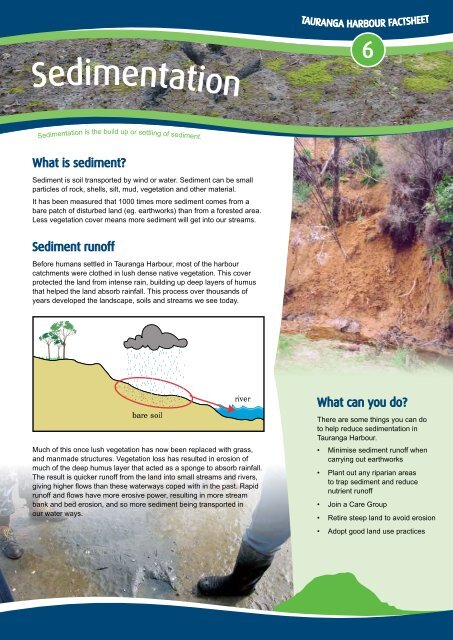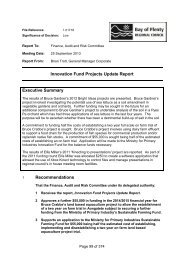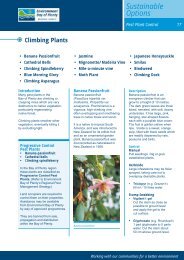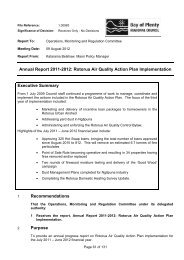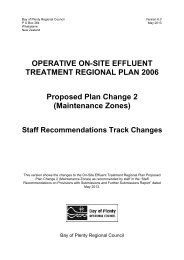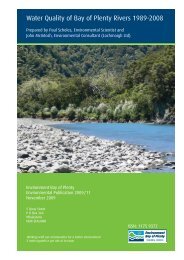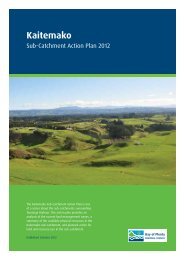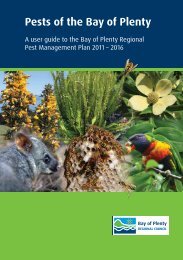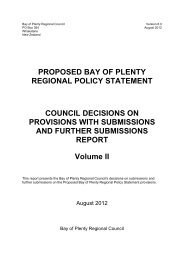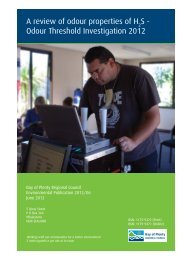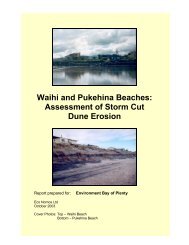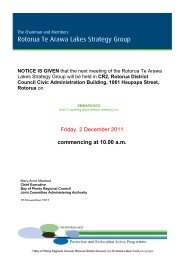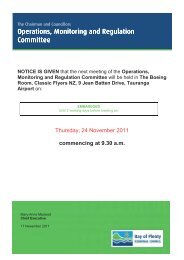Sedimentation - Bay of Plenty Regional Council
Sedimentation - Bay of Plenty Regional Council
Sedimentation - Bay of Plenty Regional Council
You also want an ePaper? Increase the reach of your titles
YUMPU automatically turns print PDFs into web optimized ePapers that Google loves.
<strong>Sedimentation</strong><br />
<strong>Sedimentation</strong> is the build up or settling <strong>of</strong> sediment.<br />
What is sediment?<br />
Sediment is soil transported by wind or water. Sediment can be small<br />
particles <strong>of</strong> rock, shells, silt, mud, vegetation and other material.<br />
It has been measured that 1000 times more sediment comes from a<br />
bare patch <strong>of</strong> disturbed land (eg. earthworks) than from a forested area.<br />
Less vegetation cover means more sediment will get into our streams.<br />
Sediment run<strong>of</strong>f<br />
Before humans settled in Tauranga Harbour, most <strong>of</strong> the harbour<br />
catchments were clothed in lush dense native vegetation. This cover<br />
protected the land from intense rain, building up deep layers <strong>of</strong> humus<br />
that helped the land absorb rainfall. This process over thousands <strong>of</strong><br />
years developed the landscape, soils and streams we see today.<br />
bare soil<br />
river<br />
Much <strong>of</strong> this once lush vegetation has now been replaced with grass,<br />
and manmade structures. Vegetation loss has resulted in erosion <strong>of</strong><br />
much <strong>of</strong> the deep humus layer that acted as a sponge to absorb rainfall.<br />
The result is quicker run<strong>of</strong>f from the land into small streams and rivers,<br />
giving higher flows than these waterways coped with in the past. Rapid<br />
run<strong>of</strong>f and flows have more erosive power, resulting in more stream<br />
bank and bed erosion, and so more sediment being transported in<br />
our water ways.<br />
TAURANGA HARBOUR FACTSHEET<br />
What can you do?<br />
There are some things you can do<br />
to help reduce sedimentation in<br />
Tauranga Harbour.<br />
• Minimise sediment run<strong>of</strong>f when<br />
carrying out earthworks<br />
•<br />
•<br />
•<br />
•<br />
6<br />
Plant out any riparian areas<br />
to trap sediment and reduce<br />
nutrient run<strong>of</strong>f<br />
Join a Care Group<br />
Retire steep land to avoid erosion<br />
Adopt good land use practices
<strong>Sedimentation</strong><br />
While the soil is being carried by the water it is referred to as suspended<br />
sediment. It blocks out light that is needed by aquatic plants like sea grass to<br />
live. Shellfish and fresh water species that feed by filtering water through their<br />
systems cannot feed, as the sediment in the water clogs their filters.<br />
<strong>Sedimentation</strong> Process<br />
river<br />
<strong>Sedimentation</strong> is the process where sediment settles and builds up which is<br />
<strong>of</strong>ten referred to as accretion. <strong>Sedimentation</strong> and accretion are the opposite <strong>of</strong><br />
erosion, where sediment is removed. Lots <strong>of</strong> sedimentation or accretion can<br />
make a river or harbour shallower over time. <strong>Sedimentation</strong> has affected many<br />
aspects <strong>of</strong> harbour life and can interfere with many harbour uses. For example,<br />
in the harbour navigation channels have shallowed, mangroves have spread<br />
and some habitats such as sea grass beds, spawning sites, juvenile fish areas,<br />
and shellfish beds have been buried or are degrading.<br />
The amount or rate <strong>of</strong> sedimentation in Tauranga Harbour has increased<br />
over the years because <strong>of</strong> population growth, changing land use and soil<br />
disturbance related to development.<br />
What is being done?<br />
estuary/harbour<br />
suspended sediment<br />
sedimentation<br />
To reduce sedimentation and improve the health <strong>of</strong> our streams and<br />
harbour Environment <strong>Bay</strong> <strong>of</strong> <strong>Plenty</strong> is able to help land owners develop farm<br />
environment plans. These include actions such as fencing streams,<br />
re-vegetating steep land, controlling erosion and promoting other good<br />
land use practices.<br />
We have helped members <strong>of</strong> the community to develop Care Groups which<br />
work to improve the health <strong>of</strong> their local area – whether that be land, streams,<br />
estuaries or coastal areas.<br />
Environment <strong>Bay</strong> <strong>of</strong> <strong>Plenty</strong>, Tauranga City <strong>Council</strong> and Western <strong>Bay</strong> <strong>of</strong> <strong>Plenty</strong><br />
District <strong>Council</strong>, use planning tools such as the Smartgrowth Strategy, <strong>Regional</strong><br />
and District Planning and resource consents to promote good land use practice<br />
to protect the harbour.<br />
TAURANGA HARBOUR FACTSHEET<br />
Where can I get more<br />
information?<br />
The earthworks guideline report has<br />
some useful information and can<br />
downloaded from www.envbop.govt.nz.<br />
Or contact…<br />
Environment <strong>Bay</strong> <strong>of</strong> <strong>Plenty</strong><br />
Phone: 0800 ENV BOP (368 267)<br />
Tauranga City <strong>Council</strong><br />
Phone: 07 577 7000<br />
Western <strong>Bay</strong> <strong>of</strong> <strong>Plenty</strong><br />
District <strong>Council</strong><br />
Phone: 07 571 8008


